Workplace stress less tips
Explore our top strategies to create a positive and healthy workplace environment that boosts morale and well-being for everyone. Implementing these tips can help you cultivate a space where employees feel supported, motivated, and happy to be a part of the team.
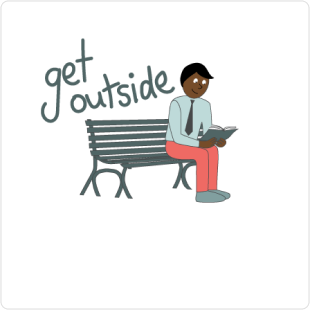
Get outside on your work breaks
Being exposed to natural light, greenery and fresh air can help boost our mood when we’re feeling low. It’s also a great way to move our bodies, even if it is a gentle walk to the closest park or a stroll around the block. The chance to get some Vitamin D is also a positive.
Action Individual
On the way to and from work
- Take an unusual route and notice what looks different
- Take a walk through a park or leafy streets
- Observe the changing of the seasons
- Notice five things that are beautiful, unusual or pleasant
In your breaks
- Plant a tree, flowers or some seeds
- Take a moment to sit outside and get some Vitamin D in the sunshine
- Walk barefoot or lie on the grass
- Look at the sky and notice the colours and shapes in the clouds – you might even sketch them
- Listen for birdsong, running water or other sounds in your environment
- Visit a space that you find relaxing or meaningful
- Feel the cool of a breeze or the warmth of the sun on your face
- Explore your local area and take notice of new things
Set yourself up for success
- Get natural light early in the day
- Go outside and do something playful – walk, run, explore
- Each time you’re outside, use all of your senses to experience each sight, smell, sound
Action Organisation
Engage your staff
- Encourage staff to take breaks and step outside
- Share research and resources with staff about the benefits of getting outside
- Provide outdoor walking, meeting and sitting spaces
Activity Ideas
- What is Green Exercise and Should You Be Doing it? – Queensland Health
- Why Forest Bathing is Good for Your Health – Greater Good Magazine
Research
- Benefits of Walking, Hiking and Running In Parks – NSW Government, Office of Environment and Heritage
- Five Ways Nature Can Boost Your Mental Health – Psychological Health Care
- How Nature is Good for Our Health and Happiness – BBC
- It’s Official, Spending Time Outside is Good for You – ScienceDaily
- The Mental Health Benefits of Nature – Mindfulness & Clinical Psychological Solutions
- The Positive Effects of Nature on Your Mental Well-Being – PositivePsychology.com
- Spending at least 120 Minutes a Week in Nature is Associated with Good Health and Wellbeing Nature International Journal of Science
- We are Wired to Be Outside – National Geographic
- Why Being Near the Ocean Can Make You Calmer and More Creative – HuffPost Australia
- Why You Should Tell Your Team to Take a Break and Go Outside – Harvard Business Review
- 5 Ways Being in Nature Changes Your Brain, According to Science – Bustle
Resources
- Healthy Parks Healthy People South Australia 2016-2021 – Government of South Australia, Department for Environment and Water
Ted Talks
- Get Hooked on Nature – Ben Klasky
- Get Back to Nature for Good Mental Health – Caroline Arnold
- Prescribing Nature for Health – Dr Nooshin Razani
- Want to be More Creative? Go for a Walk – Marily Oppezzo
- Those who are “Nature-Wise” Have an Edge in Today’s World – Ronna Schneberger
Prioritise the top 3 tasks
Setting and achieving goals plays a big role in us feeling motivated and engaged at work. Making an actionable list of tasks helps us focus our attention and achieve the goals we set for ourselves. Focussing on the top three ensures that we prioritise our efforts for the best outcome.
Action Individual
While working
- Streamline emails by turning off pop-up notification emails, allocating specific times to check and respond and setting up filters to automatically file unimportant emails
- Track your daily activities and how much time each task takes to give you a realistic view of how you spend your time, as well as when time is wasted
- Note your energy levels at different times of the day to help you plan which activities you should be doing and when
- Schedule your most challenging tasks for when your energy level is greatest, for example, if you’re most focused and creative in the morning, then use that time to do your writing or brainstorming, rather than respond to emails
When feeling stuck or overwhelmed
- Plan a fun or exciting activity to look forward to
- Commit to starting on your project and take a small step towards it
- Find the joy in completing a task you’ve put off for some time
- Reframe a problem you face as a potential opportunity
- Identify and spend time in environments that unlock energy and creativity, then use that energy to work on a goal
- Focus on the one thing you can do to make everything else easier or unneccesary
- Visualise achieving your goal and how you will feel once you have done so
- Take time to reflect on what you have achieved this week
- Take time to recognise and celebrate your successes
- Use positive self-talk
- Break projects down into smaller, more manageable actions you can take
Set yourself up for success
- Start your day with the most important task for that day
- Spend time setting up your filing systems for emails, computer documents and papers as it will save you time in the long run
- Keep your workspace clean and organised so you can focus on tasks at hand
- Delegate tasks that are less important or that others could do better, when possible
- Be aware of distractions
- Learn to say no
- It’s easy to get caught up in the details and end up spending too much time on a task so learn ways to counter unhelpful perfectionism
- When creating your list of priorities, be realistic about your capacity at any given time
- Dedicate chunks of time to single tasks rather than sporadically or while multitasking, to ensure they are given the time that they need
- If there are resources that would allow you to utilise your time more effectively, ask for support or discuss it with your manager
- Create a “stop doing” list – it can be just as important as a “to-do” list
- Create tomorrow’s to-do list, the afternoon or night before
- Create next week’s to-do list, the Friday afternoon (the week) before
- Focus on Priorities to Get Off the Busyness Rollercoaster! – The Serenity Collective
Action Team
While working
- Be aware of the workloads of each staff member and their capacity at any given time
- Check in with each of your staff about how they are going with their workload
- Limit unnecessary meetings and set boundaries so you’re not being continually interrupted
- Establish regular check-ins to ensure others are on track, especially if waiting for someone else to complete their work before you can complete yours
- Establish priorities and expectations, in writing, with team members regarding individual responsibilities and timelines
- Send out reminder emails regarding project timelines to ensure everyone is on the same page and help identify potential issues that can be solved with early intervention
Action Organisation
- Run training sessions on time management and project management
- Establish project management templates to assist staff to manage their project and save time by using templates
Activity Ideas
- How to Demonstrate Effective Time Management Skills – Houston Chronicle
- How to Ruthlessly Prioritize Tasks to Get More Done – Zapier
- Important Time Management Skills for Workplace Success – The Balance Careers
- The “Everything Is Important” Paradox: 7 Practical Methods for How to Prioritize Work – RescueTime
- These Seven To-Do List Mistakes Could Be Derailing Your Productivity – Fast Company
- Tips for Getting and Staying Motivated – Reachout.com
- Prioritization: Less Is More – Wavelength
- Why You Never Finish Your To-Do Lists at Work (and How to Change That) – The Muse
- 3 Questions That Will Give You Instant Clarity on Your Work Priorities – The Muse
- 11 Top Tips for Time Management – Career FAQs
- 12 Ways to Master Your Calendar and Manage Your Time for Maximum Results – Entrepreneur
Research
- Are Distractions Making You Underperform? – Thea O’Connor
- Employee Productivity Statistics: Everything You Need to Know for 2019 – Dynamic Signal
- Goal Progress and Happiness – Psychology Today
- Harnessing Willpower to Meet Your Goals – American Psychological Association
- How to Spend Way Less Time on Email Every Day – Harvard Business Review
- What You Can Do Tonight for a Better Workday Tomorrow – Greater Good Magazine
- 10 Ways to Trick Your Brain Into Being More Productive, According to a Neuroscientist
- Business Insider Australia
- 12 Mistakes You Might Be Making in the First 10 Minutes of the Workday – Business Insider Australia
Resources
- Setting Priorities Worksheet – Google Images
- Take Back Your Life – ABC Life
- The 3-Strike System: How to Prioritize Your To-Do List – MakeUseOf
- Time Management & Productivity Tools & Resources – Real Life E
- Time Management Templates – Google Images
- Top 10 Best To-Do List Apps to Simplify Your Task Management in 2020 – HubSpot
- 10 Psychological Tricks to Stay Motivated and Stick with Your Goals – Nick Wignall
- 12 Time Management Apps to Organize Your Life and Keep You on Track – Shopify Blogs
Ted Talks
- How to Succeed? Get More Sleep – Arianna Huffington
- How to Gain Control of Your Free Time – Laura Vanderkam
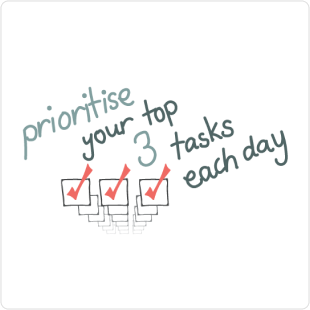
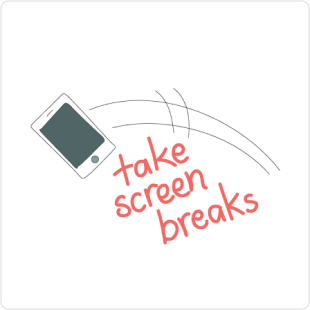
Take regular breaks from your screens
The most effective breaks help us to switch off and give our brain and body a chance to reset. Ideally, we would use this time to step away from our screens, including phones. Even the presence of a phone nearby has been found to increase the stress hormone cortisol. Whether we take solo breaks or connect with a colleague, taking a break helps to clear our minds and refocus.
Action Individual
On the way to and from work
- Take notice of your surroundings or read a book instead of scrolling through your phone during your commute
While working
- Keep your phone in your bag or locker, or at least face down when at a desk
- Try the 20-20-20 rule – every 20 minutes, look away from your screen at something which is 20 feet away, for at least 20 seconds to give your eyes a break
- Sit back in your chair and daydream for a few minutes
- Talk to people instead of emailing or IM’ing
- Put away your technology and really focus on the person you are with and give them your full attention
In your breaks
- Set timers to get up for 5 mins each hour – for a drink, toilet, walk around the office or building
- Eat lunch away from your desk, or even outside if it’s a nice day
- Put your phone away while you eat
- Bring a novel or something fun to read in your breaks
Set yourself up for success
- Use an alarm clock to set alarms, not your phone
- Turn off as many notifications as possible, especially push notifications
- Turn on automatic replies, use them to set expectations for when you are contactable and when people can expect to receive a reply from you. Do the same with your phone’s voicemail
- Turn off your phone when possible
- Set your phone to silent/vibrate/do not disturb mode
- Designate “screen-free time”
- To reduce light damage to your eyes, turn down the screen’s brightness and try a program such as Flux that helps reduce blue light at nighttime
- Unsubscribe from newsletters in your inbox you never read so you spend less time sorting through emails you don’t need
- Find a screen detox buddy to set goals and keep you on track
Action Team
In meetings
- No mobile phones or other technology in meetings to encourage staff to practice their communication skills
- If you must have your phones in a meeting, try ‘phone stacking’ – everyone puts their device in the middle of the table and the first to reach for theirs has to do a forfeit e.g. make everyone a cup of tea
- Take meetings outside when possible
In online communication
- Use the subject line of an email to indicate urgency or timelines in order to give staff the option of reading emails later, e.g. “action by COB today,” “before lunch,” or “prepare for next staff meeting”
- Let colleagues know that you’ll be checking emails at specific times and will be able to respond only to the most urgent ones outside of those times
- Make sure staff know when people are on leave, so they are not bombarded with unnecessary emails, phone calls and texts and so they don’t feel they have to work during time off
Action Organisation
Set up the physical space
- Create ‘Smartphone break areas’ or ‘Phone-free zones’
- Set a timer so everyone in the office takes a break away from their desks at morning tea or afternoon tea to stand and stretch
Create policies to support wellbeing
- Set boundaries for outside hours communications, such as email cut-off times, e.g. no emails before 9am, between 12-2pm, after 6pm
- Create an hour-long window on a weekly or even daily basis where everyone works on tasks that don’t need a computer, which can help employees be more focussed or encourage more face-to-face collaboration
- Support staff to leave their work laptops and mobile phones at the office instead of taking them home
Engage your staff
- Encourage your staff to take regular breaks away from the computer screen – share research about the benefits, if needed
- Allow more flexibility through resetting expectations for email or call response times
- Don’t assume an email is less intrusive than a phone call. Set limitation on out-of-hours contact, including emails – if a call would not be appropriate at that hour, neither is an email
Activity Ideas
- Are Your Staff Switching ‘Off’? – Bupa
- Healthy Break Activities – Workplace Strategies for Mental Health
- How to Stop and Take a Break – Thea O’Connor
- Power Breaks – Quick Relaxation – YES Psychology & Consulting
Simple Behaviours to Protect Yourself from Computer Neck Pain & Headaches – Beyond Ergo - The Practical Guide to Taking Intentional Breaks at Work – Medium
- You’re Taking Breaks the Wrong Way, Here’s How to Fix That – Fast Company
- 6 Signs You Need a Tech Break (and What to Do About it) – Ecology Runner
- 8 Ways to Disconnect from Technology and Get More Done! – Huffington Post
- 9 Ways to Start (and Stick to) a Digital Detox – The Telegraph UK
- 11 Ways to Encourage Mental Breaks from Technology in the Workplace – Forbes
Activity Research
- Brief Diversions Vastly Improve Focus, Researchers Find – ScienceDaily
- Conquering Digital Distraction – Harvard Business Review
- Constant Technology Access Stresses Australian Workers – Safety Solutions
- Digital Detox: What’s the Big Deal? – Global Leadership Wellbeing Survey
- How Do Work Breaks Help Your Brain? 5 Surprising Answers – Psychology Today
- Is Your Smartphone Making You Dumb? – Psychology Today
- Reach for Your Cell Phone at Your Own Risk: The Cognitive Costs of Media Choice for Breaks – AKJournals
- Take Back Your Lunch Break – ExecutiveStyle
- The Problem of Not Taking Breaks at Work – Medium
- The Psychological Tricks Keeping You Online – Melli O’Brien
- The Science of Taking Breaks at Work: How to Be More Productive by Changing the Way You Think About Downtime – Buffer
- Why and How You Should Take Breaks at Work – Psychology Today
- Why Taking a Lunch Break Boosts Productivity – Heidi Dening
- Why You Should Take a Relaxing Lunch Break – Greater Good Magazine
- 9 Shocking Things That Happen to Your Brain When You Get a Phone or Email Notification – Bustle
Resources
- Apps and Tech to Keep You Healthy at Work – Minutehack
- Breaks – Australian Government, Fair Work Ombudsmen
- Can You Switch Off? – Michelle McQuaid
- Four Simple Timers That Remind You to Take Breaks from Your Computer – How-To Geek
- How to Configure Your Cell Phone for Productivity and Focus – Medium
Ted Talks
- A Year Offline, What I Have Learned – Paul Miller
- Why Do We Sleep? – Russell Foster
- Need A Digital Detox? – Tania Mulry
- How Better Tech Could Protect Us From Distraction – Tristan Harris
- Are We Controlling Technology Or Is It Controlling Us? – Julia Hebron
- Breaking Free from Technology – Luis Almeida
- Cell Phones, Dopamine, and Development – Barbara Jennings
- Could You Live Without A Smartphone? – Anastasia Dedyukhina
- How Better Tech Could Protect Us From Distraction -Tristan Harris
- How Smartphones Change The Way You Think – Jeff Butler
- Learning To Look Up Again – Controlling Your Smartphone Addiction – Ross Sleight
- Quit Social Media – Dr Cal Newport
- Return to Analog – How to Break the Digital Leash – Ernest Barbaric
- Sleep Is Your Superpower – Matt Walker
- Taking A Break From Smart Phone Connectivity – Izzy Chevre
- The Tech Disconnect – Chris Bruno
- What I Learned When I Gave Up My Cell Phone – Hays Edmunds
- What If Technology Itself Is A Barrier? – Saranya Agarwal
- What You Are Missing While Being a Digital Zombie – Patrik Wincent
- What You Need To Know About Internet Addiction – Dr Kimberly Young
- Why Our Screens Make Us Less Happy – Adam Alter
- Why Is Mobile Technology The Toughest Shackle To Break? – Arman Moussavi
- Why We Should Rethink Our Relationship With The Smartphone – Lior Frenkel
Review your financial goals
Being in control of our finances and feeling financially secure is important for our wellbeing. Individuals who develop even a rough financial plan experience lower levels of financial stress and those who feel in control of their finances are more confident about their ability to achieve personal and professional goals.
Action Individual
Work out your goals
- Go to a website for free information and resources to help you set and reach goals
- Take the LifeValues quiz to determine what you value most
- Consider how much you would have to earn to meet your goals
Set yourself up for success
- Create a budget with clear goals
- Track your spending – via spreadsheet or an app
- Start a savings plan
- Make a plan to pay off your debts
- Make time over the year to check in on your financial goals to maintain a healthy financial life (and reduce stress), eg monthly, quarterly, half yearly
- Automate your savings and bill paying
- Sign up to a financial institution that offers no account fees
- Learn skills to help you negotiate a pay raise, better loan terms, and so on
- Focus on what you can control
Try different approaches to spending and saving
- Consolidate and build your super
- Change one thing you do regularly to save some extra money e.g. buying coffee every day
- Make your lunch at home
- Buy less clothes or shop vintage and second hand
- Only pay for things with cash
- Have a no spending day each week or fortnight
- Challenge yourself to a 30 Day Financial Fast
Action Organisation
Engage your staff
- Organise financial wellbeing seminars by experts for all staff to attend or access
- Provide access to resources on financial wellbeing on your intranet, social media or internal newsletters and team meetings
- Give staff wellbeing time to manage their finances (e.g. bank visits, phone calls)
- Check in with staff when they are experiencing life changes that may impact on their finances
- Audit the organisation’s salaries, considering equity across all demographics and positions
Activity Ideas
- Simple Ways to Save Money – ASIC’s MoneySmart
- 5 Habits You Can Learn from Financially Secure People – TAL
- 10 Basic Steps – Smart About Money
Research
- Simple Ways to Exploring Financial Wellbeing in the Australian Context – Centre for Social Impact
- Financial Wellbeing: A Survey of Adults in Australia – Australia and New Zealand Banking Group Financial Wellness in the Australian Workplace – AMP
- Findings of the Stress and Wellbeing in Australia Survey 2015 – Australian Psychological Society
- Improving the Financial Wellbeing of Australians – Commonwealth Bank, The University of Melbourne & Melbourne Institute
- The Financial Fitness of Working Australians – Map My Plan
- WSSA Workplace Financial Wellness Index – CoreData Research
- Barefoot Investor (Website)
- Business, Personal and Family Budget Templates – Microsoft Office
- Calculators & Resources – Australian Securities and Investments Commission’s (ASIC) MoneySmart Finances – Australian Government, Department of Health, Head to Health
- Get Your Money On Track – ASIC’s MoneySmart
- Invest/Financial Planning – HerMoney Media
- Life Events & You – ASIC’s MoneySmart
- Listen Money Matters (Website)
- Managing Financial Stress Effectively – Acacia Connection
- MoneyMinded – Australia and New Zealand Banking Group
- Mozo (Website)
- Sorted (Website)
- Sugarmamma.TV (Website)
- What Does Your Attitude to Money Say About You? – BBC Teach
- Women & Money (Website)
- Women Talk Money (Website)
- Your Financial Wellness (Website)

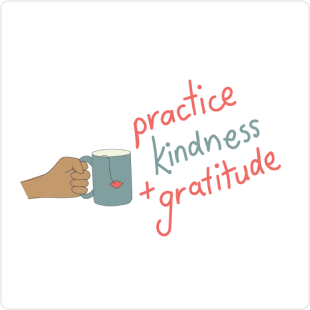
Practice kindness and gratitude at work
Being kind and showing gratitude towards ourselves and others helps us gain perspective, connect with others and be kinder to ourselves. There are scientifically proven benefits of being kind. Kindness increases oxytocin, serotonin, energy, happiness and lifespan, and decreases pain, stress, anxiety, depression and blood pressure.
Action Individual
On the way to and from work
- Check in with how you’re feeling and the energy you’re bringing to work
- Be kind to service people like bus drivers, baristas and cleaners; say hello, smile, ask how they are today
- Reflect on something you’ve done well at end of each day
When working
- Send an encouraging email to a teammate expressing appreciation
- Endorse a skill or leave a positive recommendation on LinkedIn
- Notice when you’re hard on yourself or others and find ways to be kind
- Try to make a positive comment in every interaction
- Be specific when expressing thanks and say why you are grateful for someone’s work or help
- Take a moment to accept compliments and reflect on them
- Relay the positive feedback you heard about someone’s work if they weren’t there to hear it first-hand
- Be a mentor to others by sharing your expertise or professional networks
- Congratulate someone on their wins
- Speak highly of a colleague to their supervisor
In your breaks
- Take the time to get to know a new staff member
- Buy a colleague a coffee or make them a cup of tea
- Make an effort to find out something interesting about a co-worker
Set yourself up for success
- Make a list of amazing things that you take for granted
- Write down three specific things that have gone well recently
- List the kind things others have done for you that week
- Take time each day to be grateful for the things in your life, in your head or in a journal
- Look for something to be thankful for where you least expect it
- Take time to take care of yourself, physically and emotionally; isn’t selfish, it’s essential
- Find something kind to say to yourself when feeling low
- Treat yourself the way you would treat a friend when things are difficult
Action Team
- Ensure you thank all involved in a project, including those who normally get missed or who work behind the scenes, and recognise their specific contributions
- Acknowledge team members when they are doing something well or have achieved goals
- Recognise employees’ individual motivations and reward achievements accordingly
- Take the time to greet each other in the morning, even if it’s just a smile and a wave
- Create a practice during meetings of expressing gratitude for the work of a colleague or something positive that has happened since the last meeting
- Provide personal and professional development opportunities to show you are investing in your team
Action Organisation
- Introduce an “appreciation wall”, either online or on a noticeboard
- Organise a fundraiser at your workplace to bring people together to support a worthy cause
- Organise a volunteering day for your staff
- Incorporate kindness and gratitude into performance reviews
- Offer support and flexibility when employees are experiencing personal difficulties
Activity Ideas
- How Gratitude Can Improve Your Physical and Mental Health – Mind Coaching Australia
- The Dalai Lama’s Translator Explains Why Being Kind to Yourself is Good for the World – The Washington Post
- The Heart and Science of Kindness – Harvard Health Publishing, Harvard Medical School
- Three Simple Ways to Be Kinder to Yourself Starting Today – Melli O’Brien
- Want to be Happy? Be Grateful – Michelle McQuaid
- 5 Ways to Integrate Kindness into the Workplace – Think Kindness
- 10 Creative Ways to Boost Kindness in the Workplace – CEO World Magazine
- 28 Phrases the Most Likable Employees Use at Work – Inc.
Research
- A Case For Kindness In The Workplace – Jostle
- A Simple ‘Thank You’ Goes a Long Way – Superfriend
- General Wellbeing – Gratitude – Black Dog Institute
- How Gratitude Can Transform Your Workplace – Greater Good Magazine
- Proof That Positive Work Cultures Are More Productive – Harvard Business Review
- The Benefits of Gratitude – The Positive Psychlopedia
- The Benefits of Kindness – The Positive Psychlopedia
- The Grateful Brain: The Neuroscience of Giving Thanks – Psychology Today
- The Power of Gratitude in the Workplace – ScienceDaily
- The Science of Kindness – The Random Acts of Kindness Foundation
- Workplace Gratitude Boosts Mental Wellbeing – Superfriend
- 14 Health Benefits of Practicing Gratitude According to Science – PositivePsychology.com
Resourcces
- Give and Take Quiz – Michelle McQuaid
- Gratitude Journal Guide: Tips, Templates, Ideas and Examples – Penzu
- Gratitude Journal Templates – Google Images
- Kindness Printables – The Random Acts of Kindness Foundation
Ted Talks
- My Journey to Thank All the People Responsible for My Morning Coffee – AJ Jacobs
- My 38 Random Acts of Kindness – Botlhale Tshetlo
- The Power of Kindness – Brooklyn Decker
- Want to Be Happy? Be Grateful – Brother David Steindl-Rast
- Why Being Respectful to Your Coworkers Is Good For Business – Christine Porath
- Kindness Is the Cure – A Call for Kindness – Cindy Grimes
- Why Kindness Is Good for You – Dr. David Hamilton
- Remember to Say Thank You – Dr. Laura Trice
- 365 Grateful Project – Hailey Bartholomew
- Creating Happiness Through Kindness – Isadora Dantas
- The Hidden Power of Kindness – Jennifer Willis-Rivera
- Gratitude Sticks: Why Small Acts of Kindness Matter – Kaitlin Garrity
- Expressing Appreciation – Kate MacAleavey
- The Transformative Power of Gratitude – Katia Sol
- We’re Wired for Kindness – Katri Saarikivi –
- How One Act of Kindness A Day Can Change Your Life – Mark Kelly
- The Power of Appreciation – Mike Robbins
- The Power of Kindness – Raegan Hill
- The Hidden Power in a Breath of Gratitude – Rory Ledbetter
The Power of “Thank You” Seoyoon Song
Two Words That Can Change Your Life – Tanmeet Sethi
Take a step towards a life goal
Setting new goals and thinking about the future helps us to see the bigger picture and re-evaluate life in a positive way. They help to inspire, motivate and direct our choices; they’re a reflection of what matters to us. Breaking bigger goals down into small, actionable steps helps ensure we achieve them.
Action Individual
In your breaks
- Listen to podcasts on things that interest you
- Make a call to connect with someone or an organisation who could help you
- Look up something that you’re interested in online
At work
- Find new ways to use your strengths and talents
- Craft your work activity, if you can, to align more with your goals
- Find a buddy to talk it over with, help you make a plan and keep you accountable
- Discuss your personal development plans and training opportunities with your supervisor
Outside of work
- Talk to someone about your goal or idea
- Enrol in a weekend or night class
- Volunteer in something that aligns with your goal
- Connect with people who might have achieved a similar goal that you can learn from
- Tap into your creativity (even if you think you have none!) write, paint, draw
- Link up with people who share your interest either in person or online
Set yourself up for success
- Make a commitment to make a small step each week towards your goal
- Broaden your knowledge by reading different newspapers, magazines, websites, listen to a different podcast or watch a new television show you might not usually watch
- Be open to new experiences and opportunities
- Share your goals and wins with others so you can stay motivated and celebrate together
Action Organisation
Engage your staff
- Allow staff time to volunteer with value-aligned organisations, whether ongoing or one-off
- Organise a speaker to come in and educate about goal-setting
- Run a creativity session for staff to reflect on their personal goals and how they can achieve them
Activity Ideas
- Do Something Near You (Website)
- Meetup (Website)
- The Centre for Volunteering (Website)
- Volunteering Australia (Website)
Research
- Focus Your Goals on Who You Want to be, Not What You Want to be – Inventium
- Goal-Setting Theory of Motivation – International Journal of Management, Business, and Administration
- HARD Goals, Not SMART Goals are the Key to Career Development – Forbes
- The Psychology of Willpower: Training the Brain for Better Decisions – PositivePsychology.com
- The Science and Psychology of Goal-Setting – Positive Psychology.com
- Willpower – James Clear
- 3 Ways to Help Your Employees with Goal-Setting – Entrepreneur
Resources
- The importance, benefits and value of goal setting – Positive Psychology
- Career Goals: Developing a Vision for Professional Growth – CareerAddict
- Find the Why – my career habit
- Goal Setting: 5 Science Backed Steps to Setting and Achieving Your Goals – Science of People
- Goal Setting Printable Worksheet – Google Images
- How to Set Goals for the Life You Actually Want – Fast Company
- How You Can Get Motivated and Reach Your Goals – Forbes
- Personal Development Plan Template – Google Images
- Personal Development Resources – Personal Coaching Information
- Set Personal Goals for Work – WeWork
- What is Goal Setting and How to Do it Well – PositivePsychology.com
- 5 Ways to Set Goals… and Achieve Them – Benestar
8 Ways to Stay Motivated to Follow Through on Your Goals – Happify Daily
Ted Talks
- 23 Best TED Talks on Personal Development – Self Improvementa
- Achieve Your Dreams Through Visualisation – Pete Canalichio
- Forget Big Change, Start with a Tiny Habit – BJ Fogg
- Four Keys for Setting and Achieving Goals – William Barr
- How to Achieve Your Most Ambitious Goals – Stephen Duneier
- How to DREAM Big and Achieve Your Goals and Dreams – Ian Hacon
- If You Want to Achieve Your Goals, Don’t Focus on Them – Reggie Rivers
- Life and Its Real Goals – Vivek Atray
- Setting Goals That Matter – Samantha Kris
- Why Set Life Goals and Achieve Them – Leena Munot
- Why the Secret to Success is Setting the Right Goals – John Doerr
- Why You Should Define Your Fears Instead of Your Goals – Tim Ferriss
- Your Next Step – Rachel Smets

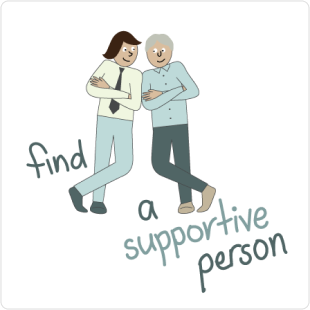
Find a supportive person at your
We rely on our colleagues for advice, support, networks and social connection. According to this study, those who have good relationships with co-workers have better physical and mental health and reduced risk of burnout. If concerned about someone at work, make a regular time to check in with them or encourage them to speak with their manager, HR or health professional.
Action Individual
Set up the conversation
- When wanting to check in with a colleague, find a quiet moment to talk in private – suggest going for a walk outside of the office
- Open up your body language by relaxing shoulders and uncrossing arms
- Practice active listening by nodding and acknowledging what they are saying
- Be mindful of your choice of words and tone of voice
- Minimise distractions, including screens and phones
During difficult conversation
- Take an active interest and ask open-ended questions like, “How are you doing?” to try and understand how the other person is feeling
- Unless someone specifically asks for your advice, it’s best to withhold your opinions
- If someone shares something personal, acknowledge their openness and trust in you
- Make specific offers, rather than just asking “How can I help?”, to make it easier for the other person make a choice and to help you set boundaries and not feel overloaded
- If needed, ask others for help after getting consent from the person needing support
- If the other person is open to it, help them reframe their situation, break it into manageable chunks, and make a plan of action
- If appropriate, encourage the person to take time to better care for themselves, which may include exercising, eating well, getting involved in social activities and speaking with a doctor or psychologist
Action Team
- Refer people to resources at work, such as an Employee Assistance Program (EAP) if you have one and, if appropriate, offer to help make an appointment
- Suggest they seek support and talk through different options
- Discuss with the employee what, if anything, they would like others to be told about their situation and how it is conveyed
- If adjustments to someone’s work have been made, communicate changes with the rest of the team in a way that protects the employee’s privacy
- Manage absences where required and review workloads of other team members to ensure they are not unfairly burdened by changes
- Work with the employee to form an agreement about what kinds of communication, if any, are shared with them during longer periods of leave
- Support employees on their return by working together to set up an individualised return to work plan
Acction Organisation
Set up your workplace
- Ensure your organisation has return to work policies that cover mental, as well as physical, illness
- Review your organisation’s existing mental health awareness programs and their effectiveness
- Talk about mental health without judgement
- Start your meetings/conversations with a wellbeing check-in
Seek expert advice on supporting employees
- Engage human resources specialists, occupational rehabilitation providers or Employee Assistance Programs (EAP) that may be available to the business
- Obtain written permission from the employee to speak with their treating health professional about how the workplace can support their recovery
Engage your staff
- Explore the possibility of making reasonable adjustments to support an employee to stay at work before assuming they will need time off
- Consider implementing empathy training workshops or consult your Employee Assistance Program, if you have one, for guidance
- Increase managers’ confidence and skills, and wider mental health literacy, by offering Mental Health First Aid training to all staff
- Utilise coaching for managers on maintaining good relationships with their staff
Activity Ideas
- RUOK at work
- 10 Creative Ways Organisations are Supporting Employee Mental Health Remotely
- Helping a Coworker Who’s Stressed Out – Harvard Business Review
- Helping a Team Member With Stress – Bupa
- How to Have More Empathy: Learn the Four Attributes of Empathy From Brené Brown – Melli O’Brien
- How to Improve Your Relationships at Work – Forbes
- How to Offer Support to a Grieving Colleague – Harvard Business Review
- How to Support a Colleague with Anxiety – Bupa
- How to Support Employees Through Grief – Altius Group
- Supporting a Colleague with Cancer – Cancer Council
- Supporting Someone at Work – Beyond Blue, The Mentally Healthy Workplace Alliance, and Heads Up
- The Art of Being a Great Coworker: 13 Ways to Improve Your Work Relationships – Hubspot
- Tips for Better Conversations with Men – MensLine Australia
Research
- Do You Need a Friend at Work? – Dr Jenny Brockis
- How Investing in Caring for Others Helps Us All – Dr Jenny Brockis
- Want to Improve Your Relationships? – Michelle McQuaid
- Work Wives and Husbands, Research Says You Need One – HRM (Australian HR Institute)
- Ending Loneliness Together White Paper
Resources
- Conversations Matter Professional Resources – Everymind
- Practical Steps Leaders Can Take to Drive the Disability Inclusion Agenda – Australian Network on Disability
- Supporting Co-Workers – Australian Government, Department of Health, Head To Health
- Supporting Others – Beyond Blue, The Mentally Healthy Workplace Alliance, and Heads Up
Ted Talk
- Building a Psychologically Safe Workplace – Amy Edmondson
- The Critical Importance of Friends on Your Happiness – Mike Duffy
- Why Good Leaders Make You Feel Safe – Simon Sinek
Get some laughter in your day
Laughter is a great way for people, whether friends or strangers, to connect positively. It is also a great way to relax our muscles, reduce tension and change our mood. Laughter even improves emotional wellbeing and feelings of optimism, improves our memory and decreases the stress hormone, cortisol.
Action Individual
On the way to and from work
- Listen to a funny podcast on your commute
- Watch your favourite comedian or comedy show on YouTube
At your desk
- Decorate your work space with objects that remind you of fun experiences or memories
- Keep jokes at your desk to give yourself a break in between tasks
In meetings
- Incorporate playful elements in your presentations, where appropriate e.g. add humour or puns to titles
In your breaks
- Find 5 minutes to laugh each day, e.g. share a joke, funny YouTube video etc.
Set yourself up for success
- Find a way to laugh at yourself – a funny friend or colleague can help
- Make someone laugh or smile every day
Action Team
While working
- Try and inject some fun and humour into your work day or team meetings
- If a team member has a talent in making people laugh, try and leverage their strength
In breaks
- Send funny pics, memes or YouTube videos to colleagues you know will like them
- Work with your team to create bios with playful statements
- Create opportunities for staff to have breaks and release tension at stressful times of the year
Action Organisation
Set up the physical space
- Create a humour at work board that staff can pin funny announcements, quotes, photos and thoughts of the day
- Start a library of funny things that people can read or watch
- Create a humour first aid kit with funny props, funny costumes and books people can access when they need a break
Create opportunities for laughter
- Host a “watch party” over lunch where you can share in funny movies or clips together
- Hold a mini laughing yoga session
- Host regular activities, like trivia, to create a shared team experience and give everyone something to look forward to
Engage your staff
- Encourage managers and leaders to share funny stories with their team
- Give people permission to have more fun at work
- Brainstorm ideas to create a more fun work environment
- Create a “Humour at Work Team” to coordinate and implement fun ideas
Activity Ideas
- Laughter Yoga for Mental Health – Action for Happiness
- Leading With Humor – Harvard Business Review
- Want To Innovate? Science Says, Be Playful! – The Creativity Post
Research
- A Laugh a Day Keeps the Doctor Away – PositivePsychology.com
- Benefits of Laughter – Laughter Online University
- How Humour Can Reduce Workplace Stress – Australian National University
- Seven Ways Laughter Can Improve Your Wellbeing – Stanford Medicine
- The Economics of Workplace Laughter, Boosts Morale, Positivity, Productivity – Laughter Online University
- The Surprising Ways Humor Can Improve Your Work Culture – Fast Company
- We Should Take Humour in the Workplace More Seriously – World Economic Forum
- Why Humor Works In Workplace Wellness Communications – Hope Health
- 10 Reasons Why Humor is a Key to Success at Work – Forbes
- 30 Benefits of Humor at Work – Humour That Works
- Humor in the Workplace Articles – Humor at Work

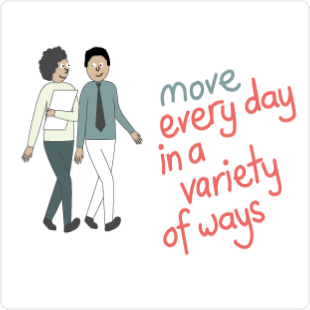
Move more every day in a variety of ways
Being physically active is one of the best ways to maintain our wellbeing, both physical and mental. Our often-sedentary lifestyles mean we spend a lot of time sitting, whether commuting or at a desk, or while watching television or using our computers. Being more active, whether it’s strenuous or not, is much easier to do if it’s something we enjoy or can build into our routines.
Action Individual
On the way to and from work
- Walk or ride part of the way to work
- Park further away from work and enjoy the walk
- Get on/off public transport one stop earlier and walk the rest of the way
- Stand on public transport
- Walk a different route to/from work
At your desk
- Move your feet by doing ankle circles or flexing them up and down to improve circulation
- Try using a standing desk
- While waiting for the photocopier, microwave or kettle, do some small exercises such as heel raises where you stand on your toes, shoulder rolls, stretching arms over your head
- Vary your work tasks so you change posture and use different muscles, e.g. filing after a period of typing
- Stand during phone calls
- Instead of calling or emailing an office colleague, walk over to speak with them
- Do stretch and breathe exercises over the course of your workday to stop the slump at your desk – you can incorporate mindfulness into this too
In meetings
- Get out of your chair and walk to reception to meet visitors, instead of just ‘sending them in’ or having the assistant collect them
- Alternate between sitting and standing off to the side of the room during meetings, presentations or at conferences
- Use headsets or a speakerphone during teleconferences so you can stand or move around
- Try swapping a seated meeting with a standing or walking meeting
At your desk
- Volunteer to do the coffee run for your colleagues
- Take the stairs over the elevator, you could combine this and use another floor’s restroom
- Stand and take a mini break from your computer every 30-45 minutes – set an alarm to remind you to get up and move regularly
- Go for a walk or do some stretches to clear your head when you feel a bit stressed at work
- Get moving at lunch time to switch your brain off from work
Set yourself up for success
- Leave comfortable clothes and shoes at work so you are ready for impromptu exercise
- Buy a fitness tracker and set some goals – you can even get competitive with yourself/friends/family/colleagues
- Commit to doing something active every day, even for 15 or 20 minutes
- Learn and practice some muscle relaxation techniques
- Make time to attend an activity club, sport or class to attend before, during or after work
Action Team
While working
- Encourage staff to walk or take public transport to external meetings rather than drive
- Encourage staff to use their lunch breaks to move more
- Send reminders or calendar invites to your team to take a break and move
- Have standing or walking meetings
- Take regular short breaks during long meetings or training sessions so that participants can stand up and stretch
- Vary tasks for your team, and time spent on them, so they are regularly moving their bodies in different ways over the day
In breaks
- Organise an outdoor physical activity everyone can take part in or enrol in a local or national activity-based fundraising challenge
- Go for a long walk at lunch as a team
- Explore new lunch options further away from work for team lunches e.g. picnic at a park
- Commit to doing something active as a team every week
- Create mini breaks during the workday to stop and do something fun
Action Organisation
Set up the physical space
- Provide standing desks
- Put signs near elevators encouraging staff to take the stairs instead
- Centralise printers and rubbish bins to encourage people to move more
- Put up posters of stretches and exercises to promote movement throughout the day
- Provide access to bike facilities or changing rooms
Create opportunities for movement
- Establish practices such as standing and walking meetings
- Support flexible work arrangements
- Offer or subsidise activities like lunchtime sports, yoga or gym memberships
- Establish a walking group at work and go for walks each week
Engage your staff
- Collect information about your workers’ commute by asking them via a survey, e.g. Worker Travel Survey
- Identify barriers and solutions for active travel options, such as the availability of showers and change rooms and accessibility by public transport
- Make your office a fun place to move and play with challenges for staff, like Steptember
- Educate staff on the benefits of incidental activity and moving more often
Activity Ideas
- Active Workplaces – Heart Foundation
- Energised, Happy and Healthy Employees Move More – Australasian Sustainable Wellness Academy
- Fitness for Free – Queensland Department of Health
- Ideas and Advice to Move More – Health Promotion Agency
- Move More Every Day to Combat a Sedentary Lifestyle – Harvard Medical School
- Sedentary Work – Sit Less and Move More In Your Work Day – Workplace Health And Safety Queensland
- The New Exercise Trend That Is Made For Everyone – The University of Sydney
- 10 Things to Know If You’re Planning to Start Exercising – Queensland Health
- 30 Fun Ways to Get 30 Minutes of Physical Activity Today – Queensland Health
Research
- Australia’s Physical Activity and Sedentary Behaviour Guidelines – Australian Government, Department of Health
- Blueprint for an Active Australia: Action Area 2 – Workplaces – Heart Foundation
- Can Physical Activity Offset the Health Risks of Too Much Sitting? – The University of Sydney
- How Simply Moving Benefits Your Mental Health – Harvard Medical School
- How to Look After Your Mental Health Using Exercise – Mental Health Foundation UK
- Physical Activity – It’s Important – BetterHealth Victoria
- Sitting Less For Adults – Heart Foundation
- 5 Reasons You Should Get Active That Have Nothing To Do With Your “Bikini Body” – Queensland Health
Resources
- BeUpstanding – a Free Toolkit for Workplaces – The University of Queensland, School of Public Health
- Get Healthy At Work – NSW Government
- Sit Less: Guide, PowerPoint and Key Messages – Health Promotion Agency
- Workplace Wellness: Resources for Workplaces – Heart Foundation
Ted Talks
- Parkour — Change Exercise as a Play – Caitlin Pontrella
- It’s Time to Re-Wild Your Body – Damien Norris
- Your Genes Are Not Your Fate – Dean Ornish
- Why Some People Find Exercise Harder Than Others – Emily Balcetis
- Mindful Exercise – Jambo Truong
- Snack on Exercise – Boost Your Mind, Body and Mood – Lauren Parsons
- The 5 ‘Musts’ to Sustainable Exercise – Michael Haddin
- The Benefits of Good Posture – Murat Dalkilinç
- Why Sitting is Bad For You – Murat Dalkilinç
- Niels Diffrient – Re-thinking the Way We Sit Down
- Got a Meeting? Take a Walk – Nilofer Merchant
- High-Intensity Physical Exercise Will Boost Your Health – Øivind Rognmo
- How to Make Hard Things Easy, and Lose Weight Too – Sameer Murali
- Why We Quit Our Exercise Plans and What We Can Do About It – Simon Long
- Exercise and the Brain – Wendy Suzuki
- The Brain-Changing Benefits of Exercise – Wendy Suzuki
Workplace Tips Assets
You can download these tips as a poster, postcard, desktop background and some cute social media tiles. Use for sharing and promoting workplace wellbeing.
eNewsletter (1)
Newsletter
eNews
Keep up to date with Wayahead Workplaces and the
Workplace Mental Health sector.
What’s included
- Industry news & upcoming events
- New and relevant research, resources, and articles
Our commitment
- Filtered, high quality information
- TLDR blurbs with high-level summaries and key takeaways


